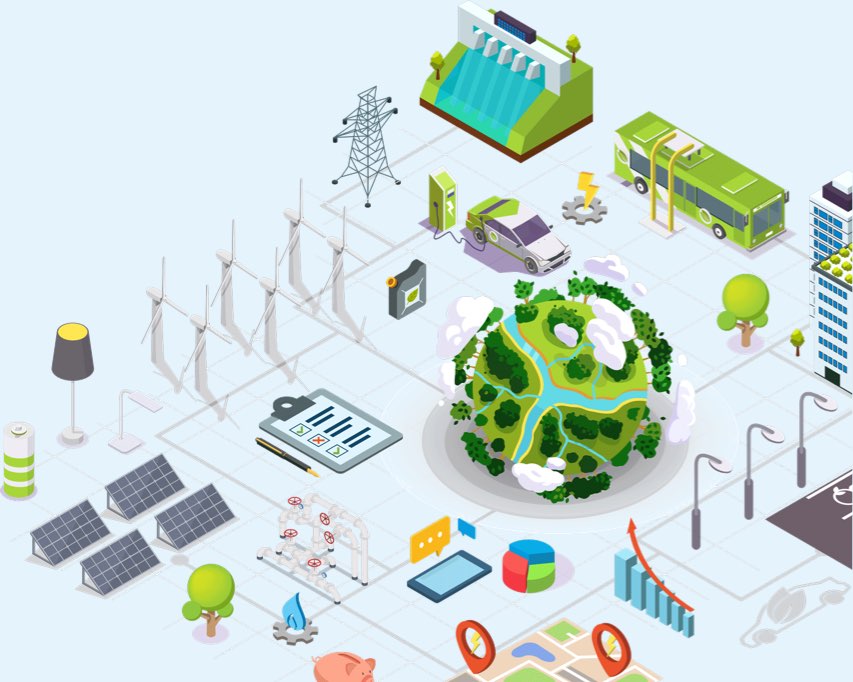Let’s talk
about our
energy future
Our 2025 Integrated
Resource Plan
The energy transition has begun in Manitoba. How energy is made, how it’s delivered and how it’s used are changing.
We’ve started to develop our 2025 Integrated Resource Plan (IRP) — a repeatable process that helps us prepare for the energy world of tomorrow. Including information about both our electrical and natural gas systems and building on learnings from our 2023 IRP, the 2025 IRP will result in a recommended development plan — a sequence of actions we’ll need to take to help ensure we’re ready for the energy future.
Manitoba needs new, dependable sources of electricity by 2030
We are preparing now to ensure we can meet future energy needs
This includes working to create a recommended ten-year development plan. This development plan will identify a series of specific actions we can take to meet future energy needs, including potentially building new infrastructure or creating new programs to reduce consumption.

What we’ve been doing
We’ve been working through Step 3 in the development process—modelling, analysis and evaluation, to test how we can serve future energy needs in various scenarios.
Two key findings have emerged that will help to guide the design and evaluation of potential development plans:
- We’ve analyzed more than 50 scenarios and sensitivities and six resource options have emerged as feasible ways to meet demand over the next ten years:
- Efficiency Manitoba’s base plan, which includes projected energy savings from Efficiency Manitoba’s 2025-28 planning analysis extended to 2050
- additional energy efficiency programs, including demand response and our curtailable rate program
- wind
- short-term utility-scale battery storage
- enhancements to existing hydropower
- natural gas/biomethane-fueled combustion turbines, where they can be fueled by natural gas, synthetic natural gas, and/or biomethane
- We’re narrowing our focus and developing a build-out target for our development plan. While not yet exact, the build-out target will help ensure we’re not planning to build too much or too little.

Learn more about the six resource options
Resource options (PDF, 1.5 MB)Next steps
We will formulate and evaluate potential development plans to eventually arrive at a short list.
These shortlisted potential development plans will move into the next phase of evaluation, where we will complete more fulsome financial and risk analysis.
We will then develop our 2025 IRP road map, which will include a draft recommended development plan. The road map will include our learnings (key insights gained from the process), near-term actions (what we will have to do in the next five years), and signposts (what external influences need to be watched, as they can impact our energy planning).
We will seek your feedback on the draft 2025 IRP road map in Round 2 Engagement, currently planned for Fall 2025.
Exploring the potential for future energy investments
Demand for energy is growing and our supply is limited. As an integrated utility with both electricity and natural gas systems, Manitoba Hydro is well positioned to meet future energy needs in the province — but work since our 2023 IRP shows a need for new energy sources within five years.
Building new energy sources and creating new energy efficiency programs takes a long time (often multiple years). That’s why we’re continuing to plan: to ensure we’re able to meet your future energy needs as demand keeps growing.
Our 2023 IRP showed us what’s possible. Using the 2023 IRP, we built a road map showing what we learned, how we need to prepare for the future, and the signposts we need to watch to help us understand how (and how quickly) the energy landscape is changing.
As we’ve been monitoring these signposts and implementing our road map, it’s become clear: soon we’re going to need more energy resources.
That means we need a new IRP. As we develop it, we will gain a greater understanding of where we might need to invest — in things like new energy sources and infrastructure, energy efficiency programming, and much more.

Building on solid foundations
Our 2025 IRP will expand on what we learned in our 2023 IRP and will include knowledge gained from monitoring signposts.

2023 Integrated Resource Plan four page summary
Download (PDF, 1.6 MB)Full report available in the document library.
What we call signposts can be described as indicators that inform on the timing, pace, magnitude or type of changes happening in the energy landscape. By reading these signposts, we can identify trends to anticipate and better understand when and how things are changing.
Our signposts include:
How we’re developing our 2025 IRP
Developing an IRP is a repeatable process, used to understand and prepare for the energy future.
Input from our customers, interested parties, and the broader energy planning community will help inform the decisions we make as we plan to provide the safe and reliable energy you count on.
Developing our 2025 IRP looks like this:
More information about our 2025 IRP process
- Our 2025 IRP process (PDF, 1.3 MB)
- Key inputs and scenarios (PDF, 1.6 MB)
- Evaluation metrics (PDF, 1.2 MB)
Your voice matters
We can’t take these steps alone. We will continue to work together with Manitobans and the energy planning community to navigate the energy transition — that’s our commitment to you.
Sign up for our mailing list to hear about upcoming engagement opportunities — and to learn what we’re hearing from customers like you.
Join the planning process
Sign up to receive updates on our 2025 Integrated Resource Plan, including opportunities to take part in the process.

Learn more about our IRP
What is an Integrated Resource Plan (IRP)?
What is an Integrated Resource Plan (IRP)?
An IRP is a tool that utilities use to understand and prepare for future energy needs. For Manitoba Hydro, it accounts for both our electricity and natural gas systems and reflects combinations of customer needs, service territory, the energy products offered to customers, existing assets, and policy drivers.
A key part of an IRP is that it includes engagement with customers and interested parties as part of its development to ensure openness and transparency in the energy planning process.
Developing an IRP is a repeatable process that can be updated as future conditions evolve.
Why are we doing an IRP?
Why are we doing an IRP?
We are responsible for supplying Manitobans with safe and reliable energy. The energy transition, and particularly decarbonization, is increasing demand for electricity — and Manitoba Hydro’s supply is limited.
Every utility around the world either is or will be facing similar challenges. We must face these challenges head-on and work to understand what we need to do to continue meeting the energy needs of Manitobans.
What’s the difference between the 2023 IRP and the 2025 IRP?
What’s the difference between the 2023 IRP and the 2025 IRP?
Through significant research and discussions with customers, governments, and other interested parties across our province, we studied in the 2023 IRP how the energy transition could impact our natural gas and electricity systems. Then, we built a plan outlining several possible energy futures, or scenarios, along with steps we can take to best monitor and prepare for whatever tomorrow brings.
The output of the 2025 IRP will be a road map that includes a development plan. This development plan will identify a series of specific actions Manitoba Hydro can take to meet future energy needs, including potentially building new infrastructure or creating new programs to reduce consumption.
Our engagement process
Our engagement for the 2025 IRP will take place over two rounds between fall 2024 and spring 2025. The purpose is to listen and gather information and feedback from our customers and interested parties to understand their perspectives and their potential future energy needs.
Why engage?
Why engage?
Engaging with customers and interested parties helps us consider a broad range of perspectives within Manitoba. This will help to make sure that the outputs of the IRP — including the recommended development plan — take these into consideration.
Round 1: Develop planning inputs
Round 1: Develop planning inputs
Between October and December 2024, we gathered information to understand customers’ and interested parties’ future energy needs and priorities. We also sought feedback to develop metrics for evaluating our options and recommending a development plan.
- Round 1 - presentation (PDF, 1.8 MB)
- Round 1 - questions asked and answered (PDF, 1.2 MB)
- Round 1 - engagement summary(PDF, 1.5 MB)
Round 2: Get feedback on our draft plan
Round 2: Get feedback on our draft plan
In Spring 2025, we’ll be seeking your feedback on our preliminary recommended development plan and our 2025 IRP road map.
Technical Advisory Committee
To ensure a broad range of input into our 2025 IRP, the Technical Advisory Committee (TAC) has been designed to gather feedback from a variety of participants with a demonstrated interest in long-term energy planning in Manitoba, from key areas of interest. As we develop our 2025 IRP, we will consider feedback from the TAC alongside feedback heard through other 2025 IRP engagement. TAC meeting materials and notes are publicly available shortly after a meeting has been held.
Meeting materials and notes
- Terms of Reference (PDF, 254 KB)
- Membership list (PDF, 97 KB)
Meeting #1 - November 8, 2024
Welcome and introduction to the 2025 Integrated Resource Plan.
- Presentation (PDF, 1.7 MB)
- Meeting summary notes (PDF, 113 KB)
Meeting # 2 - November 21, 2024
Load projections, greenhouse gas emissions and resource options inventory.
- Supporting materials (PDF, 412 KB)
- Presentation (PDF, 1.8 MB)
- Meeting summary notes (PDF, 111 KB)
Meeting #3 – December 2, 2024
Modelling, analysis, and evaluation.
- Presentation (PDF, 759 KB)
- Meeting summary notes (PDF, 170 KB)
Meeting #4 – January 31, 2025
Supplemental Session - Key concepts of energy planning.
- Presentation (PDF, 6.6 MB)
- Meeting summary notes (PDF, 146 KB)
Meeting #5
Meeting #5 was cancelled.
Meeting #6 - January 31, 2025
Preliminary modelling and analysis results.
- Presentation (PDF, 7.9 MB)
2023 Integrated Resource Plan document library
Read our report
- 2023 Integrated Resource Plan (PDF, 12 MB)
Excerpts
- Letter from the CEO (PDF, 593 KB)
- Executive summary (PDF, 1 MB)
Appendices
- Appendix 1: Existing system & load (PDF, 1.3 MB)
- Appendix 2: New resource options (PDF, 1 MB)
- Appendix 3: Scenario specific inputs (PDF, 1.3 MB)
- Appendix 4: Analysis approach (PDF, 834 KB)
- Appendix 5: Analysis results (PDF, 3.1 MB)
- Appendix 6: Policy landscape (PDF, 398 KB)
- Appendix 7: Summary of engagement process (PDF, 1 MB)
2023 IRP Engagement report
- IRP Engagement report (PDF, 10.4 MB)
- Appendix A - Supporting Materials (PDF, 4.6 MB)
Contact us
For more information about the Integrated Resource Planning process, email us.
Certain documents on this page were published before changes to provincial and federal laws about accessibility and environmental claims. We are doing an ongoing, but not completed, review to determine whether these documents, and any claims made in them, comply with the new legislative requirements.


